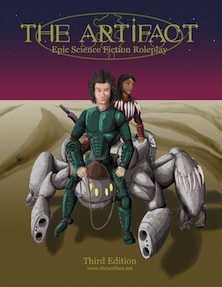Producing prior editions of The Artifact has always been a slow process. I’m one person and frequently get distracted by other projects. I just released a new novel, and released my new non-fiction book before that. I say that to emphasize my getting distracted. At the same time, I am still working on 4th Edition.
The reason I get distracted is because the new edition is a strange jump in philosophy. It feels revolutionary to me but I know that if I put it out onto the internet as it is, it would be a struggle to describe why it is so. The real revolution is that it’s doing so much that I personally want out of a game with far fewer actual core components. The core components make it easy to build in game effects with a description and a few figures.
I am in the minority among game designers when it comes to what is called crunch. I enjoy crunch, but as I get older, with less working memory to devote to, well anything, I realize that simplicity is also something that a lot of people crave.
With that in mind, I’m cutting out parts of the game that are infrequently used and collapsing some features like skills into hierarchies that mean starting players can ignore some complexity.
My position has always been that crunch creates its own kind of simplicity. It’s a conceptual simplicity. It’s a limited but rich palette that allows the players to make interesting, maybe even surprising connections.
It’s taking time for me to align the thousands of moving parts in the game and apply them evenly and effectively.
On Friday, I had a conversation with a young lady who is probably one of the most intuitive role players I’ve seen. I was surprised to find that her go to system was her favorite because she craved a less ambiguous rule set. Her favorite is a rules heavy juggernaut of a game because it provides clarity to her choices. If you want to try something, there’s a rule for it that doesn’t rely on a GM dictating how it will be handled.
This has always been my design goal for The Artifact. In other games I’ve gone with light rulesets, but the big moving gears of a fully articulated game system has always fit this game the best. I’ve tried to apply other rule sets to the world and found it didn’t sound the same. I tried at one point to port the game over to something like Savage Worlds but it never felt right.
With that, this is the lightest game I can make the game at the moment and have it still feel like it rhymes with earlier editions.
Something I’ve run into with some popular games by me and others are tools that are so modular that they seem to lose any meaning. These systems fall victim to being enticed by their philosophy into all encompassing structures. The structures are so broad that the player needs to really internalize the concepts or how they work in the story always seems hollow when applied. I might be skimming the belly of this kind of thinking with this new edition, but hopefully I’m on the side of that thin line of clarity.
This is all saying that what I’m trying to do with the new edition is to carry on the immense complexity of prior editions, build on them and use a limited palette of tools repeatedly to get a similar effect as before. It’s a complicated process. I might have something to show for it soon. I thought I was almost done before but I realized skills needed a larger overhaul than I expected. Let’s see how it goes.


 The Free RPG Blog
The Free RPG Blog